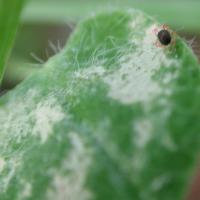Diagnosing blue oat mite
Blue oat mites (BOM) are sap-sucking pest of crops and pastures. Canola and peas are particularly susceptible. Often co-exists with redlegged earth mites.
What to look for
- Adults are 1 millimetres (mm) long with eight red-orange legs.
- Body is dark purplish-blue with a red spot on the back.
Insect Adult
- Feeding causes a silver or white discolouration of leaves and distortion or shrivelling if severe.
- Damage is more severe when seedlings are stressed (e.g. cold waterlogged or very dry conditions).
Plant
What else could it be
| Condition | Similarities | Differences |
|---|---|---|
| Diagnosing redlegged earth mite | Size, body colour and plant damage | However the RLEM has no red dot on its back |
| Diagnosing balaustium mite | Immature balaustium mites are the same size as BOM AND CAUSE SIMILAR PLANT DAMAGE | The adult balaustium mites are twice the size of an adult BOM |
| Diagnosing bryobia mite | Plant damage and leg colouration | The front legs of the bryobia mite are much larger and it causes whitish trails on the leaf surface |
Where did it come from?

Green bridge
- Over-summering eggs hatch in autumn, stimulated by cold temperatures and adequate moisture.
- BOM usually have 3 generations per season with each generation lasting 8-10 weeks.
- Mite damage tends to be worse after pastures.
- Mite damage is common in early sown crops in years with summer rain and green bridge.
Management strategies

Spraying insecticide
- Blue oat mites have higher natural tolerance to a range of pesticides. Ensure pesticide sprays are applied at registered rates.
- To prevent population build up, pesticides should be applied within 3 weeks of the first appearance of mites before adults start laying eggs.
Economic and financial considerations
To assist in assessing the economic risk and financial costs associated with various treatment strategies go to MyEconomicTool
There may be other economic and financial implications that need to be considered when choosing a management option. These may include:
Pre-crop- Understand the potential yield losses associated with earth mite feeding damage.
- Assess the costs and benefits of taking various preventative actions in the spring period in the year prior.
- Assess the cost and benefits of taking preventative action immediately prior or at seeding.
- Compare the costs, benefits and risk of each management option against doing nothing.
- Consider risk and associated costs or savings of no treatment or delaying treatment.
- Ignore all previous treatment costs when assessing current management options.
- Undertake a “what if” scenario analysis to see what impact changing variables (e.g. grain price and season conditions), have on the likely economic outcome.
- Include a resistance management strategy into your spray program to reduce the chance of earth mites and other non-target pests developing resistance.
View these economic considerations in more detail.
How can it be monitored?
- Check paddock for mites in the spring and again before seeding.
- Check for mites on the ground and leaves and for plant damage from emergence to the early vegetative stage, particularly in late sown crops.
Page last updated: Friday, 17 April 2015 - 11:24am



